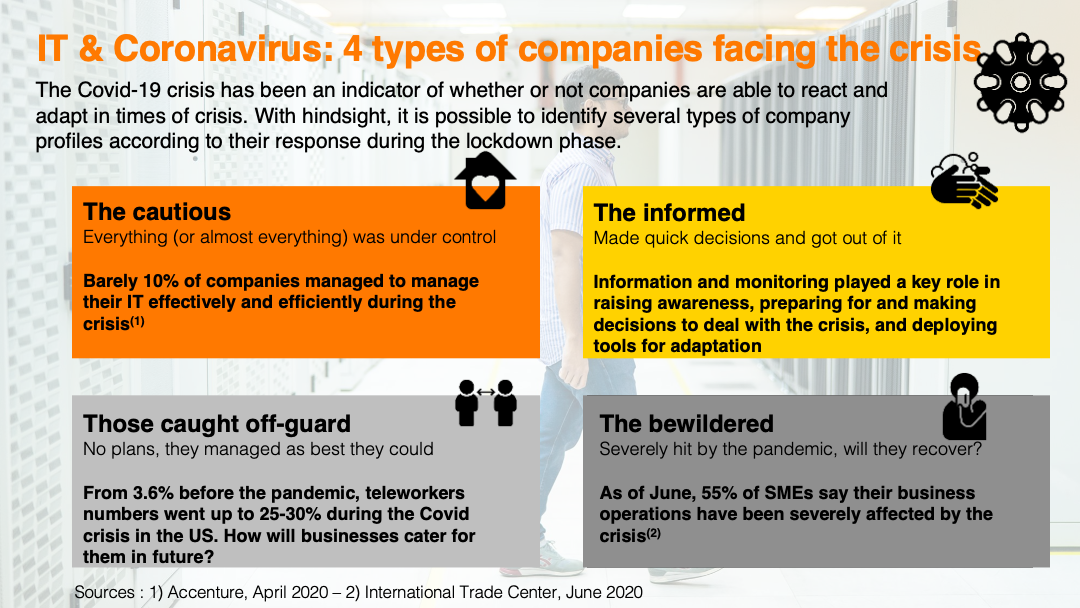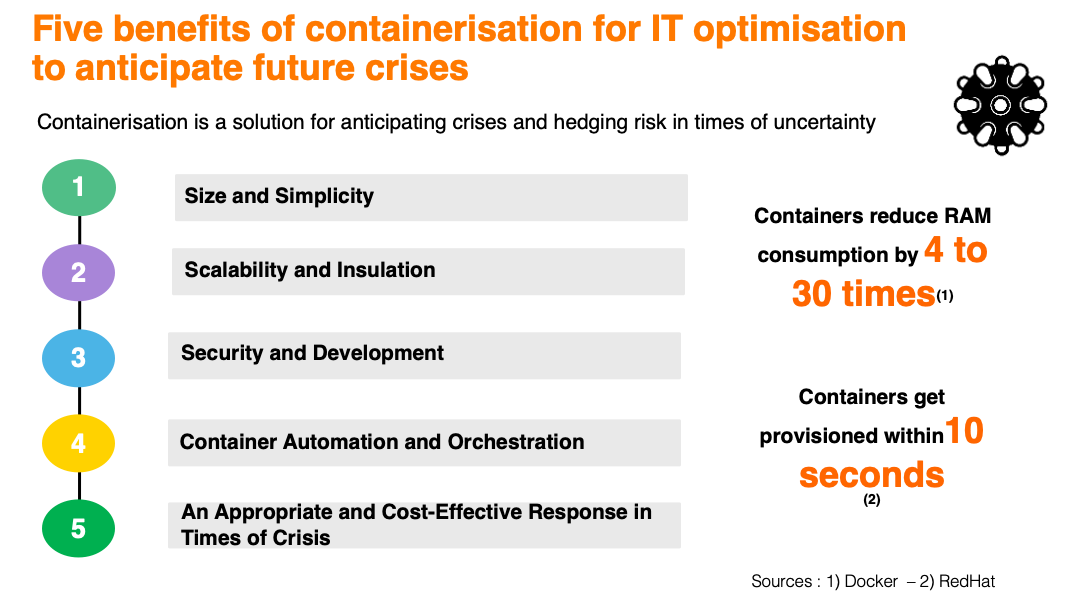The Coronavirus pandemic highlighted the ability of businesses to respond and adapt during difficult times. Utilizing their IT skills and resources, companies facilitated work-from-home for some of their employees. We have identified several types of company profiles based on how they organized their IT during the lockdown phase. Then we sketched out solutions based on container-based virtualization techniques. These scenarios could help improve the resilience of companies’ IT in anticipation of potential future crises and their probable business impact.
IT: 4 profiles of companies battling the Coronavirus crisis
We have devised four different profile types based on the way businesses managed their IT during the lockdown.

Profile no. 1 - The cautious: everything, or almost everything, was under control
This is the most favorable scenario – the one where the CIO or IT manager had previously experienced a crisis and had devised a business continuity plan to tackle it. Such as in the UK with Brexit, or in France with anti-government pension strikes in late 2019 and early 2020. However, this scenario remains by far the least observed in practice.
According to StorageCraft, only 30% of firms have a documented business continuity and recovery strategy in place. Furthermore, Accenture published a report in April 2020 from a sample of more than 8,300 businesses from 20 different industries and 20 countries, which found that only 10% of businesses effectively and efficiently administered their IT during the pandemic.
Profile no. 2 - The informed: last-minute but fast-paced decision making led to quick results
Companies operating internationally, particularly in China, were able to draw on feedback from their subsidiaries or partners and quickly take corrective action. It’s not easy to quantify the impact of such decisions, which vary significantly from one industry to another.
Profile no. 3 - Those caught off-guard: nothing was planned; they managed as best they could
The majority of enterprises have been overwhelmed by the suddenness of the crisis. They were taken by surprise and introduced last-minute work-from-home policies. Before the pandemic, only 3.6% of the U.S. population worked from home, and the number is now expected to increase to 25-30%. The question remains of the ability to provide support in the long term, which would encompass the entirety of the workforce, i.e., the portion of employees (80%) who want to work remotely in the future.
Profile no. 4 - The bewildered: severely hit by the pandemic; will they ever recover?
A majority of organizations, particularly smaller ones, are more exposed to the impact of a crisis. This is due to a lack of vision or resources, or limited planning abilities and experience. For example, 53% of companies report that they do not back up their data daily. For these players, preparation and anticipation are essential to ensure a brighter future.
Key learnings from the crisis to strengthen IT systems in anticipation of future ones
Even the cautious can learn many lessons from this crisis to prepare for an upcoming one. Scenarios for recovery proposed by experts are still a little sketchy, however. Some believe that teleworking will become the norm, or envisage drastic reductions in office space; others are less specific in their conclusions. Only one thing is sure: uncertainty will be the new normal.
Existing systems and resilience
Synergy Research values the SaaS market at over $100 billion. Horizontal applications are almost always available in cloud mode, so they are no longer a concern in the event of a crisis.
Legacy technologies, especially in-house applications, are more problematic. According to IDG, 56% of CEOs plan to keep their IT onsite in the near future. Companies that favor the business-as-usual model have not been able to set up the infrastructure they needed in time to adapt to the crisis.
Cloud computing comes out as the clear winner but is not yet always seen as a priority
IT spending will fall by 8%, according to Gartner. However, the share of cloud infrastructure will continue to grow to 54.2% of total IT spending in 2020, according to IDC. Yet, only 34% of companies consider cloud-based applications to be a priority, Gartner predicted. However, 75% of them will deploy a multicloud or hybrid cloud model as early as 2021.
The result is that a large part of the IT budget remains devoted to the day-to-day maintenance of legacy infrastructures and applications. To accelerate their digital transformation, companies must therefore shift their infrastructure to the cloud.
Atos confirms this: 70% to 80% of applications are outside the core business; they can withstand some latency and migrate to the cloud.
Five benefits of containerization for IT optimization to anticipate future crises
In this context, containerization will play a vital role in the post-crisis period and in preparing for future crises. Gartner predicts that by 2023, 70% of organizations will be running three or more containerized applications.

Benefit No. 1: size and simplicity
Let's compare containers to virtual machines (VMs). A VM embeds an OS and the applications that it supports. It runs on a hypervisor, which mimics a physical device. A container embeds the applications' file system, registry and libraries. It resorts to the OS residing on the host directly, sharing its kernel with other containers, without the need for a hypervisor.
The graphic below illustrates the differences between VMs and containers, according to Docker.

A container is, therefore, simpler and more manageable than a VM. Docker believes that it can reduce RAM consumption by 4 to 30 times. Red Hat says that while provisioning a physical server takes several days, a VM only takes 10 minutes, and a container takes merely 10 seconds.
Benefit No. 2: scalability and insulation
These two features enable containers to manage application scalability, security and resilience. By scalability, I mean that of the platform on which the container is running. Such a platform can be enhanced both in terms of computing capacity and data storage independently of the container itself. Many containers are therefore based on public clouds managed via Kubernetes.
In fact, according to a StackRox study, 33% of users of a public cloud have more than half of their applications embedded in containers (as opposed to Azure users, who have only 20%, but this number is growing quickly).
Containers virtualize the processor, memory, storage and network resources at OS level, and they are insulated from the platforms on which they run.
There are two advantages to this feature: if your infrastructure is under a security threat, containers remain insulated from it; if, on the other hand, the attack aims at either applications or data, the container can be easily isolated from the rest of the infrastructure, therefore ensuring that no other part of the information system has been compromised.
Benefit No. 3: security and development
The small size of the container and the definition of parameters related to embedded applications make it possible to reduce the footprint and perform faster backups and restores. Containers are also highly valued by developers (by 2018, a quarter of companies were already using Docker) because their design makes them easy to move or duplicate. With containers and the Kubernetes orchestrator, system monitoring is part of the infrastructure, allowing companies to implement security in a security-as-a-code mode.
Kubernetes offers security features to protect identities, confidentiality and the network. Particular attention is paid to the security of the execution environment – the host server – which allows the identification of a container acting maliciously while in production mode. Hence, relevant measures can be taken to protect the workloads and isolate them.
Benefit No. 4: container automation and orchestration
The trend to migrate to native applications in the cloud will accelerate after the Coronavirus crisis. Similarly, one will increasingly rely on Kubernetes clusters, the de facto standard for container administration.
The ultimate challenge is the automation of the management of clusters at scale, wherever they have been deployed. A high-performance management solution is a must-have if one wants to reap the many benefits of containerization, especially during times of crisis. This is why Orange Business has developed a solution that embeds Kubernetes for public and hybrid clouds.
Benefit No. 5: an appropriate and cost-effective response in times of crisis
Cost-killing will be businesses’ most crucial post-COVID exercise. The use of containers and the optimization of their management will curb the consumption of resources. Indeed, a single OS image is required for all applications running on a cluster. Besides, containers need only one copy of the application on a physical drive to launch all its instances. The result is a dramatic reduction in cost.
Post-crisis hints that businesses should heed
In conclusion, while it is challenging to predict crises and their impacts, it is nevertheless possible to prepare for the worst while hoping for the best. Containerization offers many avenues of improvement for companies wishing to make their IT more flexible and resilient in the face of an uncertain future.
Chart your course to business resilience with the help of our e-book: All things cloud: building a future-proofed multicloud strategy.

Cyril is a Business Consultant and Manager of a team of DevOps/multicloud experts. His team helps our clients optimize their information systems using the latest technologies to make them more profitable, agile and resilient.